Choose English walnut, quartersawn white oak, maple, or cherry for your wooden salt box, as they're moisture-resistant and won't affect food taste. You'll want food-safe finishes like beeswax or shellac to protect the wood, along with secure lid mechanisms using rare earth magnets. Keep your salt box at 50-70°F and use uncooked rice to absorb moisture. Confirm compartments hold 4-7.75 ounces each, and opt for rectangular openings for easy filling. Clean with dry cloths only, avoiding water-based cleaners. From traditional mortise and tenon joints to modern magnetic closures, there's much more to discover about these essential kitchen tools.
Choosing The Perfect Wood Type
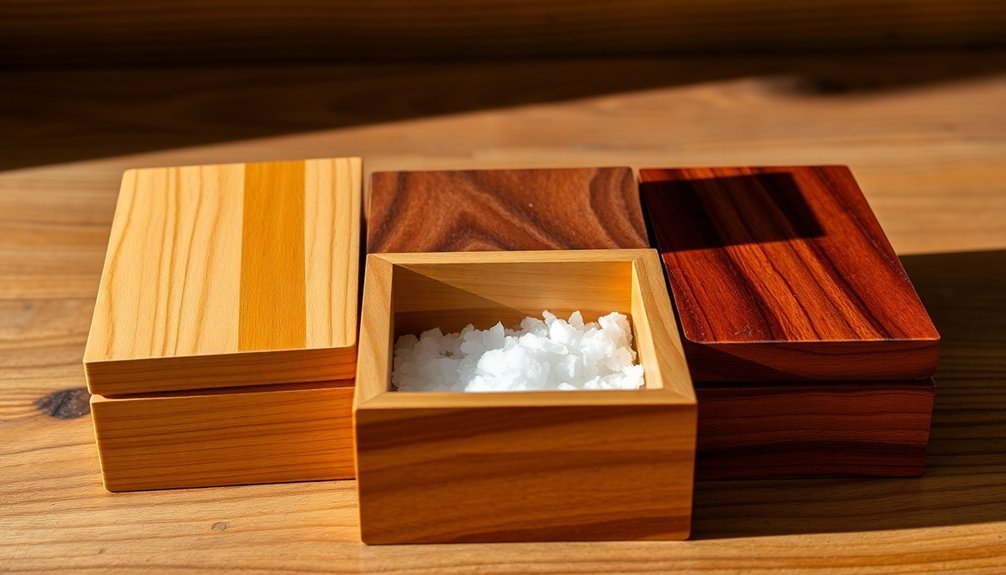
Precision in wood selection stands as the cornerstone of crafting a reliable salt box. You'll want to focus on hardwoods that resist moisture and won't affect your salt's purity. English walnut, quartersawn white oak, maple, and cherry are your top choices, offering both durability and food-safe properties.
You'll need to steer clear of woods that could compromise your salt's quality. Avoid any scented woods, color-changing varieties like Purple Heart, or those with excessive holes like Ambrosia maple. Don't use oily woods such as Cocobolo or Teak, and skip resinous options like pine or cedar, as they'll taint your salt's flavor.
When selecting your wood, look for pieces with minimal pores and a stable grain pattern. You'll find that CVG Douglas fir works well if you prefer a distinctive grain appearance. Our handcrafted salt boxes demonstrate exceptional durability through traditional construction techniques.
Start with a larger block than needed, and verify you're using food-safe finishes like beeswax or mineral oil for protection. You'll want to sand thoroughly to achieve a smooth surface that's splinter-free.
Proper Seasoning Compartment Design
You'll maximize your kitchen efficiency with divided compartments that let you store different salts and seasonings side by side, preventing cross-contamination while keeping everything within easy reach.
The swiveling or magnetic lids offer one-handed accessibility, which proves invaluable when you're actively cooking and need quick access to your seasonings. The elegant parawood construction provides both durability and aesthetic appeal to complement any kitchen decor.
Each compartment should provide adequate capacity for your cooking needs, with common designs offering between 7.75 ounces to 2/3 cup of storage space per section.
Divided Storage Space Benefits
Designed with culinary expertise in mind, wooden salt boxes with divided compartments offer significant advantages for home cooks and professional chefs alike. You'll find these compartments perfectly suited for storing multiple seasonings while preventing cross-contamination and maintaining distinct flavors. The magnetic lock system ensures your seasonings stay secure and fresh between uses.
| Storage Feature | Benefit |
|---|---|
| Separate Sections | Keep salts, herbs, and spices organized |
| Optimized Capacity | Hold up to 7.75 oz per compartment |
| Quality Protection | Natural wood allows seasonings to breathe |
The divided storage system isn't just about organization – it's about preservation. Wood materials like parawood and acacia naturally regulate moisture, preventing the "sweating" that often occurs in plastic containers. You'll notice your seasonings stay fresher longer, maintaining their original texture and flavor profiles.
Each compartment can accommodate different quantities, with options like 1/3 cup and 2/3 cup capacities. You're not limited to just salt storage; these versatile boxes work equally well for various spices, herbs, and even non-culinary items. When you're ready to clean, simply hand wash and towel dry to maintain the wood's natural properties.
Lid Accessibility Features
Crafting intuitive access points, wooden salt box lids incorporate smart features that make seasoning a breeze during meal preparation.
You'll find the swivel mechanism particularly useful, as it allows you to access your seasonings with just one hand while keeping the contents protected when not in use. This smooth action guarantees you can make quick seasoning adjustments without interrupting your cooking flow.
The magnetic closure system provides an extra layer of security for your stored seasonings. You won't need to worry about accidental spills or contamination, as the magnetic lock keeps the lid firmly in place until you're ready to use it. A simple touch is all it takes to access your spices when needed.
You'll appreciate the thoughtful refill design that lets you replenish your seasonings without removing the entire lid. Each compartment can be refilled independently, minimizing interruptions to your cooking process.
The one-handed operation feature proves invaluable in busy kitchen situations, allowing you to maintain efficiency while seasoning your dishes. You can keep stirring with one hand while accessing your salts and spices with the other, streamlining your cooking workflow.
Compartment Size Requirements
When planning a wooden salt box, proper compartment sizing makes all the difference in functionality and convenience. You'll want compartments that can hold between 4 and 7.75 ounces of seasonings per side, which translates to roughly 65 to 303 grams of storage capacity. The most practical designs feature dual compartments, with one side typically holding 1/3 cup and the other 2/3 cup of seasonings.
For ideal storage and convenience, consider these essential compartment requirements:
- Choose deeper cavities that minimize refill frequency – aim for compartments that can hold at least 4 ounces of seasonings.
- Select side-by-side configurations if you frequently use multiple seasonings while cooking.
- Opt for larger single compartments if you primarily use one type of salt or seasoning.
- Consider multi-level designs if you need to store various spices and herbs separately.
Your salt box should accommodate your cooking style while maintaining proper moisture protection.
Whether you're storing different types of salt, herbs, or spices, verify the compartments are sized appropriately for your usage patterns.
Remember that larger capacities mean less frequent refills, saving you time in the kitchen.
Moisture Control Techniques
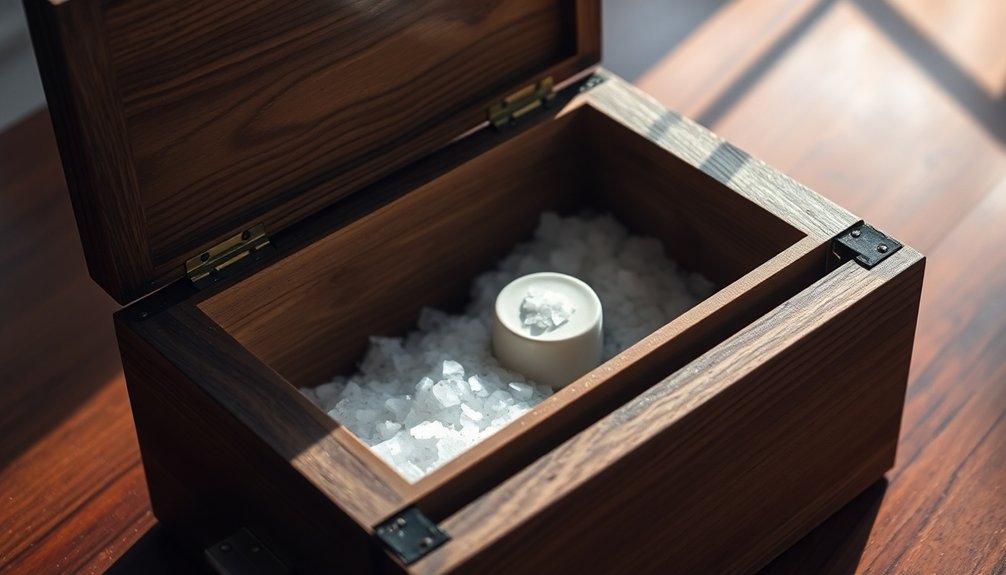
You'll want to incorporate both natural absorption methods and proper lid sealing to keep your wooden salt box's contents dry and ready for use.
Your box's airtight design features should include a snug-fitting lid that allows minimal airflow while still letting the salt "breathe" enough to maintain its quality.
To maximize moisture control, you can add a small amount of uncooked rice or coarse salt at the bottom of your wooden salt box, acting as a natural moisture absorber that protects your main salt supply.
Natural Absorption Methods
Throughout the centuries, salt boxes have relied on natural absorption methods to combat moisture and protect their precious contents. Salt's inherent ability to bind with moisture makes it an excellent natural dehumidifier, helping to maintain a dry environment within your wooden box while preventing condensation and mold growth.
You'll find that proper material selection plays a significant role in natural absorption. When you're choosing wood for your salt box, opt for moisture-resistant varieties like quartersawn white oak, cherry, or mahogany. These materials work alongside salt's natural properties to create an effective moisture barrier.
Here are four essential natural absorption techniques you can implement:
- Apply a food-safe shellac coating to the interior surfaces to enhance moisture resistance.
- Position your salt box in a well-ventilated area to complement salt's moisture-absorbing effects.
- Maintain proper air circulation without making the box completely airtight.
- Use clear, vertical grain woods for better stability and natural moisture resistance.
Remember to monitor your environment's relative humidity levels, as temperature variations can affect salt's moisture-absorbing performance.
Proper Lid Sealing
Building on natural absorption methods, proper lid sealing stands as the next line of defense against moisture intrusion in wooden salt boxes. You'll need to focus on three key mechanisms to guarantee your salt stays dry and free-flowing.
First, implement a reliable hinge and pin system using brass or metal rods. Center your pin carefully through the lid's thickness, and drill precise holes to prevent any hanging or misalignment. Once installed, test the movement and file down excess pin material for a clean finish.
For secure closure, incorporate rare earth magnets into your design. You'll want to drill opposing holes for the magnets, ensuring proper pole alignment before gluing them in place. Let them protrude slightly above the surface for better contact.
To minimize moisture infiltration, you must address gaps and airflow points. Design your box so the back pivot acts as a natural stop, eliminating spaces between the top and back.
During construction, maintain square edges and clamp components firmly while drilling. Finally, apply a food-safe finish like shellac to the interior, but keep the bottom uncoated. This combination of sealing techniques will greatly enhance your salt box's moisture resistance.
Airtight Design Features
While proper lid sealing forms the first barrier against moisture, incorporating airtight design features creates an all-encompassing defense system for your wooden salt box. You'll find that careful attention to construction details greatly impacts your salt box's ability to maintain ideal moisture levels and preserve your seasonings.
- Choose woods like quartersawn white oak, cherry, or FSC-certified varieties that naturally resist moisture and develop a protective patina over time. These materials provide inherent protection against humidity while guaranteeing sustainability.
- Look for continuous grain patterns and mitered corners that minimize gaps where air might enter. The construction should include stopped dadoes that effectively trap the back of the box, creating a more secure seal.
- Confirm your salt box features a recessed back design with a small shadow line above the top. This configuration helps maintain the box's square shape and prevents lid gapping when closed.
- Select a salt box with proper internal finishing, specifically shellac, which creates a food-safe and moisture-resistant barrier. The interior surfaces should be smooth and even, without paint, to prevent salt from clumping while maintaining ideal moisture control.
Lid Mechanisms That Last
A well-crafted lid mechanism forms the backbone of any reliable salt box, protecting your seasoning from moisture and guaranteeing years of trouble-free use.
You'll want to choose between four proven designs: hinged, pivoting, swivel, or magnetic closures.
For a hinged lid, you'll need 1/16-inch brass rods centered in precisely drilled holes, positioned 1/8 inch from the top and 3/16 inch from the edge. Test the movement before securing the pins with CA glue.
If you prefer a pivoting mechanism, opt for metal pins and use a drill press for exact hole placement, adding rare earth magnets for secure closure.
Swivel mechanisms require careful attention to the flat rim and corresponding holes for smooth operation. You'll need to apply Danish oil to protect the wood and guarantee the rod moves freely.
For magnetic lids, drill flush-fitting holes for rare earth magnets, marking their positions carefully to ensure proper alignment. Remember to check polarity before gluing the magnets in place.
Whichever mechanism you choose, focus on minimizing gaps and guaranteeing smooth operation – these details will determine how well your salt box preserves its contents over time.
Essential Maintenance Practices
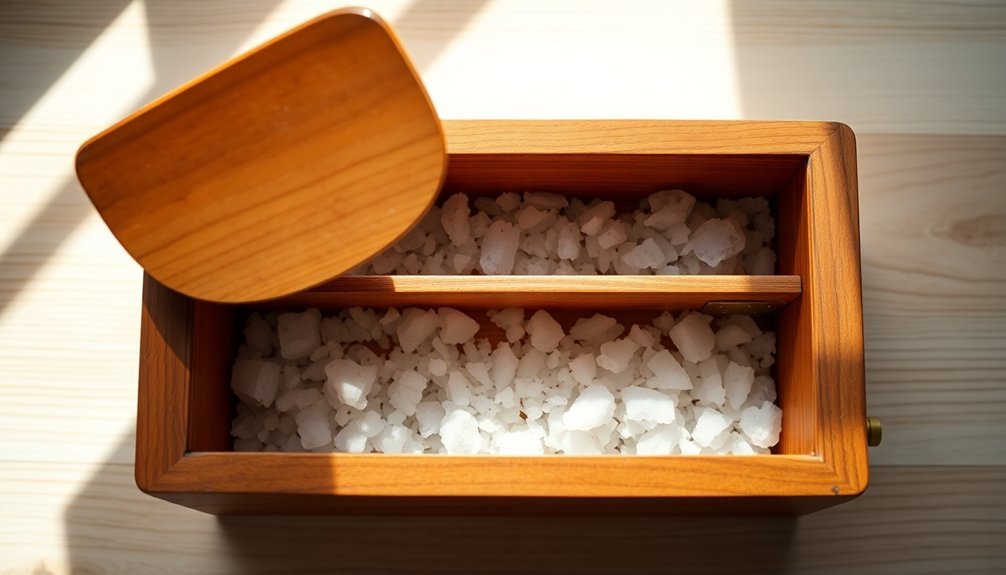
Keeping up with regular maintenance helps extend your salt box's lifespan and guarantees your seasonings stay fresh and accessible.
You'll want to focus on cleaning, protecting the wood, preventing salt deterioration, and maintaining proper closure mechanisms to guarantee peak performance.
To effectively clean your salt box, use a dry cloth to remove salt residue and debris.
Don't use soap or water-based cleaners, as moisture can damage both the wood and salt. When you spot stubborn stains, opt for a food-safe wood cleaner and guarantee the box is completely dry before refilling.
- Apply a food-safe finish using the three-stage buffing method (Tripoli, White Diamond, and Carnauba wax) to protect the wood.
- Store your salt box in a cool, dry place away from direct sunlight and humid environments.
- Choose wood types that allow salt to "breathe," avoiding plastic containers that cause salt to sweat.
- Check lid mechanisms regularly, guaranteeing magnetic catches or closures work properly.
Remember to periodically inspect your salt box for signs of wear, clumping salt, or moisture buildup.
Regular maintenance not only preserves the box's appearance but also maintains the quality of your stored salt.
Optimal Storage Temperature Conditions
Temperature control plays an essential role in preserving both your wooden salt box and its contents.
You'll want to keep your salt box in a dry storage area with temperatures between 50°F and 70°F, which provides ideal conditions for maintaining the quality of your salt and protecting the wooden container.
Store your salt box away from any heat sources, including ovens, stovetops, or direct sunlight, as these can cause temperature fluctuations that affect both the wood and contents.
Don't place it near refrigerators or freezers either, as the temperature difference can create condensation that might damage the wood.
Make certain you're keeping your salt box in a well-ventilated area to prevent moisture buildup.
You'll want to position it away from walls and slightly elevated to allow proper air circulation.
If you're storing your salt box in a pantry or cabinet, check the temperature regularly to verify it stays within the recommended range.
For ideal preservation, don't store your salt box in areas that exceed 85°F, as higher temperatures can affect the wood's integrity and potentially create conditions where moisture might accumulate within the container.
Multi-Purpose Preservation Applications
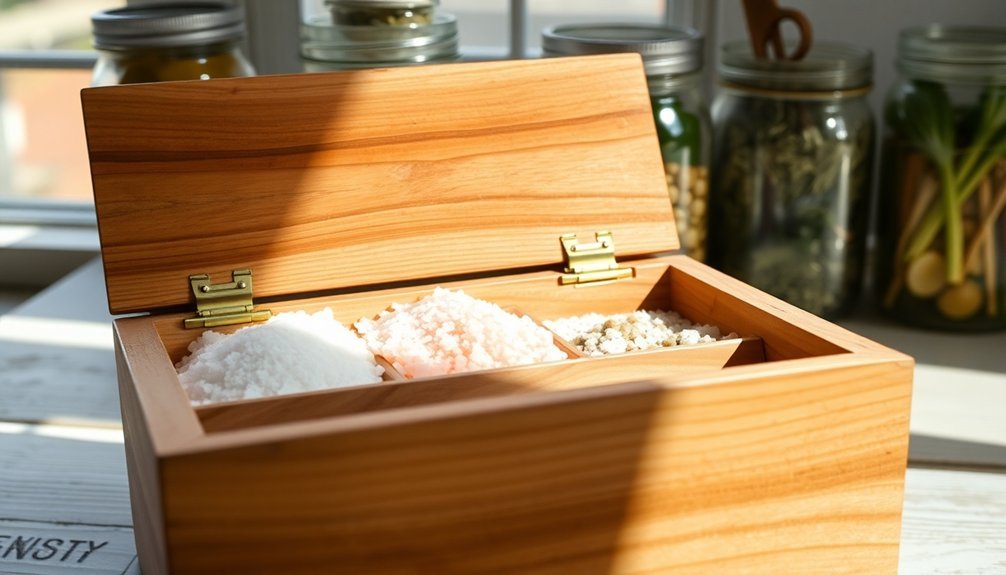
Traditional wooden salt boxes consistently prove their worth beyond basic salt storage, serving as versatile preservation tools in both modern and historical kitchens.
You'll find these dense wooden containers particularly effective at keeping salt dry and free-flowing, thanks to their breathable nature. When you're preserving food through traditional methods, these boxes become essential tools in maintaining the quality of your preserving agents.
- Store your pickling salt and preserving spices separately to maintain their distinct properties
- Keep your curing salts dry and ready for meat preservation projects
- Use compartmentalized boxes to organize different types of preservation agents
- Store specialty salts for specific preservation techniques in individual sections
You can rely on wooden salt boxes, especially those made from olive wood, to maintain the integrity of your preserving ingredients without absorbing odors or moisture.
They're particularly valuable when you're working with various preservation techniques, from meat curing to pickling. Beyond salt storage, you'll find these boxes excellent for keeping herbs, spices, and other dry ingredients fresh and accessible.
Remember to hand wash your box and occasionally apply food-grade oil to maintain its preservation capabilities.
Traditional Construction Methods
These enduring structures showcase the ingenuity of early New England craftsmen, who relied on robust timber framing techniques to create their distinctive saltbox homes.
You'll find their construction methods centered on post-and-beam framing, where large timber pieces connect through mortise and tenon joints, secured by wooden pegs and braces rather than expensive metal nails.
You'll notice the saltbox's signature asymmetrical design features two stories in front and one in back, creating that characteristic long, sloping rear roofline. This clever design wasn't just for looks – it provided an economical way to expand living space while possibly avoiding certain colonial-era taxes on two-story homes.
When examining traditional saltbox construction, you'll see the extensive use of wood throughout. The frame utilizes substantial timber pieces, while the exterior typically features clapboard siding.
Though rare exceptions exist, like the brick-built Josiah Day House, wood remained the primary building material. These construction methods, popular from 1650 to the 1830s, are experiencing renewed interest today as homeowners rediscover the practical wisdom behind these colonial-era building techniques.
Food Safety Coating Guidelines

Food safety regulations demand specific coating requirements for wooden salt boxes that come into contact with consumables. You'll need to ascertain your coating materials meet FDA standards under 21 CFR 175.300 and use only GRAS-approved ingredients. Shellac is particularly effective for wooden salt boxes, creating a protective barrier that prevents direct food contact with untreated wood.
When selecting and applying your food-safe coating, consider these essential guidelines:
- Choose FDA-cleared coatings suitable for your specific food storage needs, ascertaining they're durable enough for regular salt exposure.
- Apply multiple thin layers of shellac or food-grade finishes like mineral oil or beeswax, allowing proper drying time between coats.
- Inspect the coating regularly for signs of wear, chipping, or degradation, particularly in areas where the lid meets the box.
- Maintain documentation of your coating materials, including the manufacturer's letter of guarantee for FDA compliance.
Remember to test the coating's integrity through proper extraction testing and ascertain there aren't any gaps between the lid and box that could compromise food safety.
Your coating should be robust enough to withstand daily use while preventing bacterial contamination and moisture absorption.
Space-Saving Design Elements
Modern salt boxes incorporate innovative space-saving features while maintaining functionality and style. You'll find clever designs like stacking tiers that let you store multiple seasonings vertically, perfect for maximizing counter space. The most efficient models feature swivel or flip-top lids that you can operate with one hand while cooking.
| Design Element | Space-Saving Benefit |
|---|---|
| Stacking Tiers | Stores multiple salts vertically |
| Swivel Lid | Enables one-handed operation |
| Compact Footprint | Minimizes counter space usage |
| Rectangular Opening | Makes filling and cleaning easier |
| Magnetic Closure | Maintains secure, space-efficient seal |
When choosing your salt box, consider those with hand-friendly dimensions that hold between 76 to 303 grams of salt. You'll want to look for models crafted from space-efficient materials like bamboo or acacia wood, which offer durability without bulk. The best designs feature hinged lids with magnetic catches that keep your salt protected while maintaining a slim profile. These thoughtful elements guarantee you're getting maximum storage capacity in a minimal footprint, making your kitchen more organized and efficient.
Frequently Asked Questions
Can Salt Boxes Affect the Flavor of Different Types of Salt?
Yes, your salt box's material can affect salt flavors. If you're using wooden boxes, they'll protect delicate salts from moisture while ceramic or glass ones won't absorb odors that could alter your salt's taste.
How Long Does a Wooden Salt Box Typically Last With Regular Use?
You'll typically get 3-5 years from a well-maintained wooden salt box. However, if you're using it daily and it's exposed to moisture, it may only last 1-2 years before showing signs of degradation.
Are Magnetic Closures Safe for Storing Medicinal or Therapeutic Salts?
You shouldn't use magnetic closures for medicinal salts, as they risk contamination and aren't inherently food-safe. Instead, opt for boxes with secure, non-magnetic seals that keep your therapeutic salts pure and uncompromised.
Do Darker Wood Finishes Leave Residue That Could Mix With Stored Seasonings?
When properly cured, dark wood finishes won't leave residue in your seasonings. However, you'll want to guarantee complete curing time and stick to food-safe finishes like dark tung oil for best results.
Can Wooden Salt Boxes Be Safely Used in Outdoor or High-Humidity Cooking Areas?
You shouldn't use wooden salt boxes outdoors or in high-humidity areas unless they're properly sealed. Even then, you'll need regular maintenance. It's better to choose nonporous materials like glass or ceramic for these conditions.
In Summary
You'll appreciate how a well-crafted wooden salt box can transform your food storage routine. By applying these tips for wood selection, design features, and maintenance practices, you're set to preserve ingredients effectively while adding rustic charm to your kitchen. Remember to regularly check moisture levels and reapply food-safe coatings. With proper care, your wooden salt box will serve as a reliable storage solution for years to come.

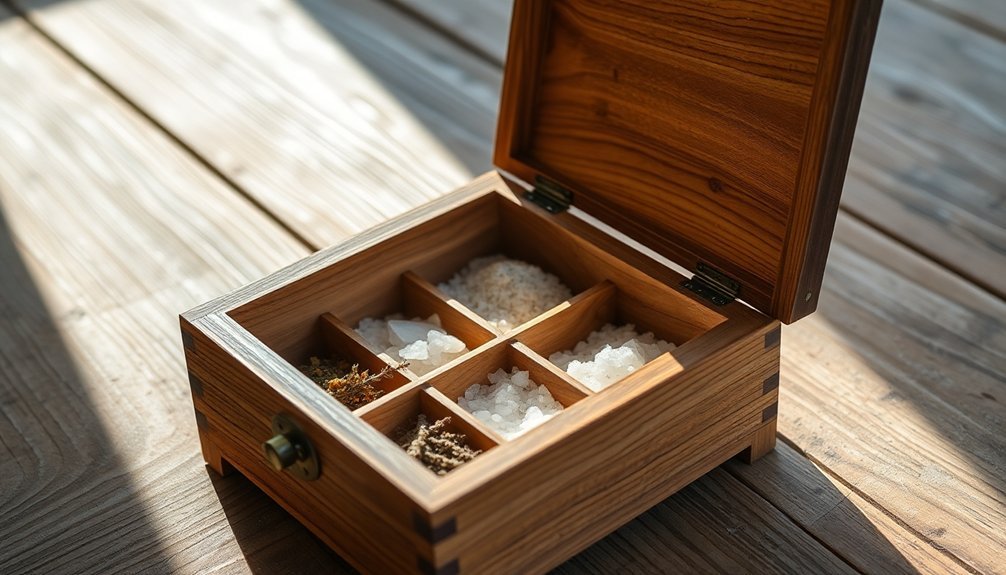



Leave a Reply